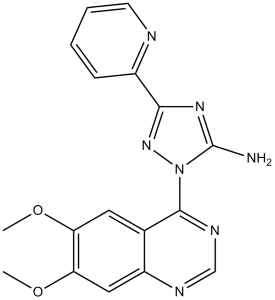CP-466722 is a novel, specific and reversible ATM inhibitor with an IC50 value of 4.1 μM, it does not affect ATR and inhibits PI3K or PIKK family members in cells. CP466722 was quickly and totally removed, which reversed the inhibition of cellular ATM kinase activity. One potentially effective medication to make tumor cells more sensitive to IR is CP-466722. Using Hela, MCF-7, and mouse cells pre-treated with IR, it was observed that an increase in ATM-dependent phosphorylation events was induced. At a minimal dose of 6 μM, CP-466722 treatment prevented ATM-dependent phosphorylation events from occurring and inhibited ATM-dependent p53 induction.
Physicochemical Properties
| Molecular Formula | C17H15N7O2 | |
| Molecular Weight | 349.35 | |
| Exact Mass | 349.128 | |
| Elemental Analysis | C, 58.45; H, 4.33; N, 28.07; O, 9.16 | |
| CAS # | 1080622-86-1 | |
| Related CAS # |
|
|
| PubChem CID | 44551660 | |
| Appearance | White to off-white solid powder | |
| Density | 1.5±0.1 g/cm3 | |
| Boiling Point | 642.3±65.0 °C at 760 mmHg | |
| Flash Point | 342.2±34.3 °C | |
| Vapour Pressure | 0.0±1.9 mmHg at 25°C | |
| Index of Refraction | 1.737 | |
| LogP | 0.83 | |
| Hydrogen Bond Donor Count | 1 | |
| Hydrogen Bond Acceptor Count | 8 | |
| Rotatable Bond Count | 4 | |
| Heavy Atom Count | 26 | |
| Complexity | 470 | |
| Defined Atom Stereocenter Count | 0 | |
| SMILES | NC1=NC(C2=NC=CC=C2)=NN1C3=C4C=C(OC)C(OC)=CC4=NC=N3 |
|
| InChi Key | ILBRKJBKDGCSCB-UHFFFAOYSA-N | |
| InChi Code | InChI=1S/C17H15N7O2/c1-25-13-7-10-12(8-14(13)26-2)20-9-21-16(10)24-17(18)22-15(23-24)11-5-3-4-6-19-11/h3-9H,1-2H3,(H2,18,22,23) | |
| Chemical Name | 2-(6,7-dimethoxyquinazolin-4-yl)-5-pyridin-2-yl-1,2,4-triazol-3-amine | |
| Synonyms |
|
|
| HS Tariff Code | 2934.99.9001 | |
| Storage |
Powder-20°C 3 years 4°C 2 years In solvent -80°C 6 months -20°C 1 month |
|
| Shipping Condition | Room temperature (This product is stable at ambient temperature for a few days during ordinary shipping and time spent in Customs) |
Biological Activity
| Targets | ATM ( IC50 = 4.1 μM ) | ||
| ln Vitro |
|
||
| ln Vivo |
|
||
| Enzyme Assay | An ELISA assay is developed to measure the phosphorylation status of the ATM downstream target p53, and an in vitro kinase assay is adapted to screen for small molecule inhibitors of ATM kinase activity. For use in the ELISA and in vitro kinase tests, recombinant GST-p53(1-101) and full-length Flag-tagged ATM & ATR are purified. In summary, 2μg of purified, recombinant GST-p53(1-101) in PBS is coated overnight at 4 °C on Nunc 96-well Maxisorp plates. The next few incubations are run at room temperature. In a final volume of 80μL of reaction buffer (20 mM HEPES, 50 mM NaCl, 10 mM MgCl2, 10 mM MnCl2, 1 mM DTT, and 1 μM ATP), the plates are washed (0.05%v/v-Tween/PBS) before being added with purified recombinant full-length ATM kinase (30 ng–60 ng) in the presence or absence of CP-466722. The kinase assay is incubated for 90 minutes after CP-466722 (10μM) is added to plates in duplicate. Anti-Phospho(Ser15)-p53 antibody (1:1000/PBS) is added to the plates, and they are then rinsed, blocked (1 hour, 1%w/v-BSA/PBS), and incubated (1 hour) after the plates have been cleaned (0.05%v/v-Tween/PBS). Plates are cleaned (0.05%v/v-Tween/PBS) to lessen non-specific binding before being incubated for 1 hour with HRP-conjugated goat anti-rabbit IgG secondary antibody (1:5000/PBS). The TMB substrate reagent is used to identify the secondary antibody that is connected to the phosphorylated GST-p53(1–101) protein. Before determining absorbance (λ450nm), plates are developed for 15–30 minutes, and the reaction is stopped at a final concentration of 1 M H2SO4. In vitro kinase assays are used to characterize CP-466722, which inhibits ATM kinase activity in ELISA assays, with regard to inhibition of ATM/ATR kinases. The anti-Phospho(Ser15)-p53 antibody is used in western blotting to measure ATM/ATR inhibition. Upstate conducts an extended analysis of CP466722 (10 μM) against a panel of kinases that is available commercially. | ||
| Cell Assay | Triple-plated HeLa or A-T (GM02052) expressing hTERT cells are incubated for a full day. Pre-treatment of cells with DMSO, CP466722, or KU55933 is done before IR (0-10Gy). After internal reflection, the cells are allowed to incubate for four hours. Afterward, the media is removed, the cells are rinsed with PBS, trypsined, tallied, and replated (2000 cells/plate, 10 cm plates) without any drug, and they are then left to incubate for ten days. Before the count of colonies, the cells undergo a series of procedures including washing in PBS, staining in PBS, rinsing in dH2O, and drying. A surviving colony is defined as a population of at least 50 cells. The data is expressed as the percentage of surviving colonies relative to the control plates plus or minus standard error. | ||
| Animal Protocol |
|
||
| References |
[1]. Transient inhibition of ATM kinase is sufficient to enhance cellular sensitivity to ionizing radiation. Cancer Res. 2008 Sep 15;68(18):7466-74. [2]. Development of a cell-based, high-throughput screening assay for ATM kinase inhibitors. J Biomol Screen. 2014 Apr;19(4):538-46. [3]. Interactions Between Ataxia Telangiectasia Mutated Kinase Inhibition, Poly(ADP-ribose) Polymerase-1 Inhibition and BRCA1 Status in Breast Cancer Cells. J Cancer Prev. 2014 Jun;19(2):125-36. |
||
| Additional Infomation | 2-(6,7-dimethoxy-4-quinazolinyl)-5-(2-pyridinyl)-1,2,4-triazol-3-amine is a member of quinazolines. |
Solubility Data
| Solubility (In Vitro) |
|
|||
| Solubility (In Vivo) |
|
| Preparing Stock Solutions | 1 mg | 5 mg | 10 mg | |
| 1 mM | 2.8625 mL | 14.3123 mL | 28.6246 mL | |
| 5 mM | 0.5725 mL | 2.8625 mL | 5.7249 mL | |
| 10 mM | 0.2862 mL | 1.4312 mL | 2.8625 mL |
